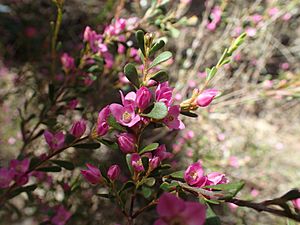Aniseed boronia facts for kids
Quick facts for kids Aniseed boronia |
|
|---|---|
 |
|
| Boronia crenulata leaves and flowers | |
| Scientific classification | |
 |
|
| Occurrence data from Australasian Virtual Herbarium |
The Boronia crenulata, often called aniseed boronia, is a plant that belongs to the citrus family called Rutaceae. It is found only in the south-west part of Western Australia. This plant is a shrub with branches that spread out, and it often trails along the ground between other plants. It has strap-like leaves and pretty pink to purple-red flowers with four petals. You can see these flowers during winter and autumn.
Contents
About the Aniseed Boronia
The Boronia crenulata is a shrub that usually grows to be about 0.25 to 1.2 meters tall (that's about 1 to 4 feet). It has thin, weak stems that often spread out and trail between other plants. The leaves can be different shapes, sometimes even on the same plant! Generally, they are about 20 millimeters long (almost an inch) and 2 millimeters wide (a tiny bit less than a tenth of an inch). They are often strap-like or egg-shaped, with the narrower part at the bottom. You might notice a few soft hairs on the leaves, and their edges usually have some small teeth.
The flowers are pink to reddish and appear one by one or in small groups. You can find them where a leaf meets the stem (this is called a leaf axil) or at the ends of the stems. Each flower is about 1 centimeter (less than half an inch) across and sits on a small stalk about 4 millimeters long. The sepals, which are like small leaves protecting the flower bud, are egg-shaped or triangular. They are about 1.5 to 2 millimeters long and usually have a sharp, pointed tip. Each flower has four smooth (meaning glabrous) petals and eight stamens, which are the parts that produce pollen.
How it Got its Name
The Boronia crenulata was first officially described in 1807 by a scientist named James Edward Smith. He published his description in a scientific paper called Transactions of the Linnean Society of London.
The second part of its scientific name, crenulata, comes from a Latin word, crena. This word means "a notch or rounded projection." This name was chosen because the edges of the plant's leaves often have small, rounded teeth, like tiny notches.
Where Aniseed Boronia Grows
This type of boronia grows in a large area in the south-west of Western Australia. You can find it in many different natural areas, including the Avon Wheatbelt, Esperance Plains, Geraldton Sandplains, Jarrah Forest, Mallee, Swan Coastal Plain and Warren regions.
It can grow in many kinds of soil, from clay to limestone. You might see it in swampy areas near the coast, or even near the edges of salt lakes and on rocky outcrops. It's quite adaptable!
Is it Endangered?
The Government of Western Australia's Department of Parks and Wildlife has listed Boronia crenulata as "not threatened." This means it is not currently at risk of disappearing.

